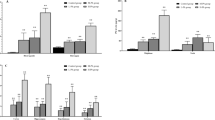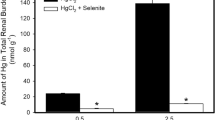Abstract
Lead (Pb) continues to be a major toxic metal in the environment. Pb exposure frequently occurs in the presence of other metals, such as arsenic (As) and manganese (Mn). Continued exposure to low levels of these metals may lead to long-term toxic effects due to their accumulation in several organs. Despite the recognition that metals in a mixture may alter each other’s toxicity by affecting deposition, there is dearth of information on their interactions in vivo. In this work, we investigated the effect of As and Mn on Pb tissue deposition, focusing on the kidney, brain, and liver. Wistar rats were treated with eight doses of each single metal, Pb (5 mg/Kg bw), As (60 mg/L), and Mn 10 mg/Kg bw), or the same doses in a triple metal mixture. The kidney, brain, liver, blood, and urine Pb, As, and Mn concentrations were determined by graphite furnace atomic absorption spectrophotometry. The Pb kidney, brain, and liver concentrations in the metal-mixture-treated group were significantly increased compared to the Pb-alone-treated group, being more pronounced in the kidney (5.4-fold), brain (2.5-fold), and liver (1.6-fold). Urinary excretion of Pb in the metal-mixture-treated rats significantly increased compared with the Pb-treated group, although blood Pb concentrations were analogous to the Pb-treated group. Co-treatment with As, Mn, and Pb alters Pb deposition compared to Pb alone treatment, increasing Pb accumulation predominantly in the kidney and brain. Blood Pb levels, unlike urine, do not reflect the increased Pb deposition in the kidney and brain. Taken together, the results suggest that the nephro- and neurotoxicity of “real-life” Pb exposure scenarios should be considered within the context of metal mixture exposures.





Similar content being viewed by others
References
ASTDR (2000) Supplementary guidance for conducting health risk assessment of chemical mixtures. Risk assessment forum U.S. Environmental Protection Agency
Fairbrother A, Wenste R, Sappington K, Wood W (2007) Framework for metals risk assessment. Ecotox Environ Safe 68:145–227
Dhatrak SV, Nandi SS (2009) Risk assessment of chronic poisoning among Indian metallic miners. Indian J Occup Environ Med 13(2):60–64
Fay RM, Mumtaz MM (1996) Development of a priority list of chemical mixtures occurring at 1,188 hazardous waste sites, using the HazDat database. Food Chem Toxicol 34(11–12):1163–1165
Binks K, Doll R, Gillies M, Holroyd C, Jones SR, McGeoghegan D, Scott L, Wakeford R, Walker P (2005) Mortality experience of male workers at a UK tin smelter. Occup Med 55:215–226
Mejía JJ, Diáz-Barriga F, Calderón J, Ríos C, Jiménez-Capdeville ME (1997) Effects of lead–arsenic combined exposure on central monoaminergic systems. Neurotoxicol Teratol 19(6):489–497
Shukla GS, Singhal RL (1984) The present status of biological effects of toxic metals in the environment: lead, cadmium, and manganese. Can J Physiol Pharmacol 62(8):1015–1031
Reglero MM, Taggart MA, Monsalve-González L, Mateo R (2009) Heavy metal exposure in large game from a lead mining area: effects on oxidative stress and fatty acid composition in liver. Environ Pollut 157:1388–1395
Rodriguez VM, Dufour L, Carrizales L, Diaz-Barriga F, Jimenez-Capdeville ME (1998) Effects of oral exposure to mining waste on in vivo dopamine release from rat striatum. Environ Health Perspect 106(8):487–491
Martinez-Finley EJ, Chakraborty S, Fretham SJB, Aschner M (2012) Cellular transport and homeostasis of essential and nonessential metals. Metallomics 4:593–605
Casarett & Doull’s (2013) Toxicology: The Basic Science of Poisons, Eighth Ed. McGraw-Hill
ASTDR (2007) Toxicological Profile For Lead.U.S. Department of Health and Human Services, Public Health Service Agency for Toxic Substances and Disease Registry.
Hodgson E (2010). A Textbook of Modern Toxicology, 4th Edition. John Wiley and Sons, IncHodgson E (2010). A Textbook of Modern Toxicology, 4th Edition. John Wiley and Sons, Inc
Gerhardsson L, Englyst V, Lundstrom NG, Nordberg G, Sandberg S, Steinvall F (1995) Lead in tissues of diseased lead smelter workers. J Trace Elem Med BioI 9:136–143
ELSafty IAM, Afifi AMH, Shouman AE, EL Sady AKR (2004) Effects of smoking and lead exposure on proximal tubular integrity among egyptian industrial workers. Arch Med Res 35:59–65
Yu D (1999) A pharmacokinetic modeling of inorganic arsenic: a short term oral exposure model for humans. Chemosphere 39(15):2737–2747
Benramdane L, Accominotti M, Fanton L, Malicier D, Vallon JJ (1999) Arsenic speciation in human organs following fatal arsenic trioxide poisoning—a case report. Clin Chem 45(2):301–306
ASTDR (2007) Toxicological Profile For Arsenic.U.S. Department of Health and Human Services, Public Health Service Agency for Toxic Substances and Disease Registry.
Hughes MF, Devesa TV, Adair BM, Styblo M, Kenyon EM, Thomas DJ (2005) Tissue dosimetry, metabolism and excretion of pentavalent and trivalent monomethylated arsenic in mice after oral administration. Toxicol Appl Pharm 208:186–197
ASTDR (2007) toxicological profile for manganese.U.S. Department of Health and Human Services, Public Health Service Agency for Toxic Substances and Disease Registry.
Santamaria AB (2008) Manganese exposure, essentiality & toxicity. Indian J Med Res 128:484–500
Simons JE (1995) Chemical mixtures: challenge for toxicology and risk assessment. Toxicology 105:111–119
Kakkar P, Jaffery FN (2005) Biological markers for metal toxicity. Environ Toxicol Pharmacol 19:335–349
Al-Attar AM (2011) Vitamin E attenuates liver injury induced by exposure to lead, mercury, cadmium and copper in albino mice. Saudi J Biol Sci 18:395–401
Pittman JK (2005) Managing the manganese: molecular mechanisms of manganese transport and homeostasis. New Phytol 167(3):733–742
Spurgeon DJ, Jones OAH, Dorne JL, Svendsen C, Swain S, Stürzenbaum SR (2010) Systems toxicology approaches for understanding the joint effects of environmental chemical mixtures. Sci Total Environ 408:3725–3734
Kalia K, Chandra SV, Viswanathan PN (1984) Effect of 54mn and lead interaction on their binding with tissue proteins: in vitro studies. Ind Health 22:207–218
Molina RM, Phattanarudee S, Kim J, Thompson K, Wessling-Resnick M, Maher TJ, Brain JD (2011) Ingestion of Mn and Pb by rats during and after pregnancy alters iron metabolism and behavior in offspring. NeuroToxicology 32(4):413–422
Creton S, Billington R, Davies W, Dent MP, Hawksworth GM, Parry S, Travis KZ (2009) Application of toxicokinetics to improve chemical risk assessment: Implications for the use of animals. Regul Toxicol Pharm 55:291–299
Andrade V, Mateus ML, Batoréu MC, Aschner M, Marreilha dos Santos AP (2013) Urinary delta-ALA: a potential biomarker of exposure and neurotoxic effect in rats co-treated with a mixture of lead, arsenic and manganese. NeuroToxicology 11(38):33–41
Bradford MM (1986) A rapid and sensitive method for the quantitation of microgram quantities of protein utilizing the principle of protein-dye binding. Anal Biochem 72:248–254
Feron VJ, Groten JP, Jonker D, Cassee FR, van Bladeren PJ (1995) Toxicology of chemical mixtures: challenges for today and the future. Toxicology 105:415–427
Migliore L, Coppedè F (2009) Environmental-induced oxidative stress in neurodegenerative disorders and aging. Mutat Res 674:73–84
Sakai T, Yanagihara S, Kunugi Y, Ushior K (1982) Relationships between distribution of lead in erythrocytes in vivo and in vitro and inhibition of ALA-D. Br J Ind Med 39:382–387
Kumar N, Boeve BF, Cowl CT, Ellison JW, Kamath PS, Swanson KL (2008) Hypermanganesia, hereditary hemorrhagic telangiectasia, brain abscess: the hepatic connection. Neurology 30(7):1118–1119
Yokel RA, Lasley SM, Dorman DC (2006) The speciation of metals in mammals influences their toxicokinetics and toxicodynamics and therefore human health risk assessment. J Toxicol Environ Health 9:63–85
CanonneHergaux F, Zhang AS, Ponka P, Gros P (2001) Characterization of the iron transporter DMT1 (NRAMP2/DCT1) in red blood cells of normal and anemic mk/mk mice. Blood 98(13):3823–3830, 15
Leinders T, van Kleef RG, Vijverberg HP (1992) Distinct metal ion binding sites on Ca(2+)-activated K + channels in inside-out patches of human erythrocytes. Biochim Biophys Acta 1112:75–82
Weed RI, Rothstein A (1960) The uptake of divalent mature normal human manganese ion by red blood cells. J Gen Physiol 44:301–314
Liu Z, Sanchez MA, Jiang X, Boles E, Landfear SM, Rosen BP (2006) Mammalian glucose permease GLUT1 facilitates transport of arsenic trioxide and methylarsonous acid. Biochem. Biophys. Res Commun 15; 351(2):424–430
Lu M, Wang H, Li XF, Lu X, Cullen WR, Arnold LL, Cohen SM, Le XC (2004) Evidence of hemoglobin binding to arsenic as a basis for the accumulation of arsenic in rat blood. Chem Res Toxicol 17(12):1733–1742
Kalia K, Narula GD, Kannan GM, Flora SJ (2007) Effects of combined administration of captopril and DMSA on arsenite induced oxidative stress and blood and tissue arsenic concentration in rats. Comp Biochem Physiol C Toxicol Pharmacol 144(4):372–379
Chandra SV, Mohd M, Saxena DK, Murthy RC (1981) Behavioral and neurochemical changes in rats simultaneously exposed to manganese and lead. Arch Toxicol 49:49–56
Charlet L, Chapron Y, Faller P, Kirsch R, Stone AT, Baveye PC (2012) Neurodegenerative diseases and exposure to the environmental metals Mn, Pb, and Hg. Coord Chem Rev 256:2147–2163
Lind SE, Park JS, Drexler JW (2009) Pyrithione and 8-hydroxyquinolines transport lead across erythrocyte membranes. Transl Res 154(3):153–159
Aschner M (2006) The transport of manganese across the blood–brain barrier. NeuroToxicology 27:311–314
Zhu G, Fan G, Feng C, Li Y, Chen Y, Zhou F, Du G, Jiao H, Liu Z, Xiao X, Lin F, Yan J (2013) The effect of lead exposure on brain iron homeostasis and the expression of DMT1/FP1 in the brain in developing and aged rats. Toxicol Lett 4; 216(2–3):108–123
Wang Q, Luo W, Zhang W, Liu M, Song H, Chen J (2011) Involvement of DMT1 + IRE in the transport of lead in an in vitro BBB model. Toxicol In Vitro 25:991–998
Kerper LE, Hinkle PM (1997) Cellular uptake of lead is activated by depletion of intracellular calcium stores. J Biol Chem 272(13):8346–8352
Gonick HC (2011) Lead-binding proteins: a review. http://dx.doi.org/10.1155/2011/686050.
Smith DR, Kahng MW, Quintanilla-Vega B, Fowler BA (1998) High-affinity renal lead-binding proteins in environmentally-exposed humans. Chem Biol Interact 115:39–52
Hodgson A, Pellow PGD and Hodgson GNS (2007) Influence of nephrotoxicity on urinary excretion of uranium. Health Protection Agency.
Nordberg M, Nordberg GF (2009) Metallothioneins: historical development and overview. Met Ions Life Sci 5:1–29
Waalkes MP, Harvey MJ, Klaassen CD (1984) Relative in vitro affinity of hepatic metallothionein for metals. Toxicol Lett 20(1):33–39
Albores A, Koropatnick J, Cherian MG, Zelazowski AJ (1992) Arsenic induces and enhances rat hepatic metallothionein production in vivo. Chem Biol Interact 85(2–3):127–140
Yu J, Fujishiro H, Miyataka H, Oyama TM, Hasegawa T, Seko Y, Miura N, Himeno S (2009) Dichotomous effects of lead acetate on the expression of metallothionein in the liver and kidney of mice. Biol Pharm Bull 32(6):1037–1042
Leslie EM (2012) Arsenic–glutathione conjugate transport by the human multidrug resistance proteins (MRPs/ABCCs). J Inorg Biochem 108:141–149
Suzuki T (1992) Imura, N and Clarkson, TW (1992) Advances in mercury toxicology. Springer, N.Y.. ISBN 0-306-44116-0
Erikson KM, Dobson AW, Dorman DC, Aschner M (2004) Manganese exposure and induced oxidative stress in the rat brain. Sci Total Environ 334–335:409–416
García-Fernandez AJ, Bayoumi AE, Perez-Pertejo Y, Motas M, Reguera RM, Ordonez C, Balana-Fouce R, Ordonez D (2002) Alterations of the glutathione–redox balance induced by metals in CHO-K1 cells. Comp Biochem Physiol 132:365–373
Acknowledgments
The authors wish to acknowledge the financial support from the Fundação para a Ciência e Tecnologia (FCT) strategic project PEst-OE/SAU/UI4013/2011, Instituto de Investigação do Medicamento (iMed.ULisboa), Faculdade de Farmácia, Universidade de Lisboa, and National Institute of Health (NIH ES R0110563, P30 ES000267). The authors also wish to thank Dr. Maria Eduarda Mendes for her guidance on atomic absorption spectrometry.
Conflict of Interest
The authors declare that there are no conflict of interests and that this publication has been approved by all co-authors.
Author information
Authors and Affiliations
Corresponding author
Rights and permissions
About this article
Cite this article
Andrade, V., Mateus, M.L., Santos, D. et al. Arsenic and Manganese Alter Lead Deposition in the Rat. Biol Trace Elem Res 158, 384–391 (2014). https://doi.org/10.1007/s12011-014-9954-2
Received:
Accepted:
Published:
Issue Date:
DOI: https://doi.org/10.1007/s12011-014-9954-2




